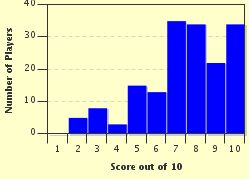Quiz Answer Key and Fun Facts
1. Just so you know what you're looking at, I'm a Blue Plaque in Portsmouth marking the house where which author and 1907 Nobel Prize winner lived as a boy?
2. I am the Blue Plaque at 13 Beach Lawn, Liverpool marking the home of Thomas Henry Ismay. I hope you don't get a sinking feeling when I ask you which of these shipping lines he acquired in 1868?
3. I'm the Blue Plaque gracing the building at 42 Hamilton Square, Birkenhead, which is one of the trading places of Sir Henry Tate. Can you be a sweetie, and tell me how he made his money?
4. If you're looking at me, you must be visiting 1 Cranbury Place, Southampton, as I'm the Blue Plaque marking the birthplace of John Jellicoe. Can you do some navel gazing to work out with which World War I battle he is associated?
5. I'm not on a dairy, and I don't want to milk it, but I'm the Blue Plaque on 32 George Road in Edgbaston, Birmingham. I commemorate the place where which of these men lived between 1872 and 1881?
6. There's no need to get into a dogfight or spit fire at me, because I'm only a Blue Plaque at 2 Russell Place, Portswood, Southampton. Which aircraft designer lived here between 1927 and 1937?
7. This could be called a strange meeting place, but I'm a Blue Plaque on 7 Elm Grove, Birkenhead, where war poet Wilfred Owen lived from 1900 until 1903. Which of these poems did he write?
8. I'm not a dinky Blue Plaque, so I hope you'll be on the right track to work out that I'm marking the home of which inventor and toy manufacturer from Liverpool?
9. Why are you calling me a goon and suggesting I should be pink? I'm the Blue Plaque which you can find on 96 Castle Road, Southsea, Portsmouth to mark the birthplace of which actor and comedian?
10. Imagine that you are outside 251 Menlove Avenue in Liverpool. You will be able to see me, because I am the Blue Plaque marking the boyhood home of which singer?
Source: Author
rossian
This quiz was reviewed by FunTrivia editor
bloomsby before going online.
Any errors found in FunTrivia content are routinely corrected through our feedback system.

